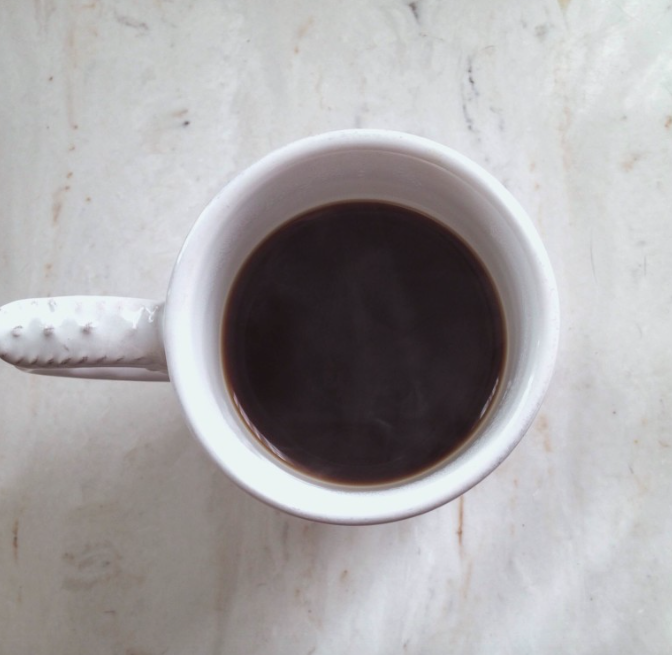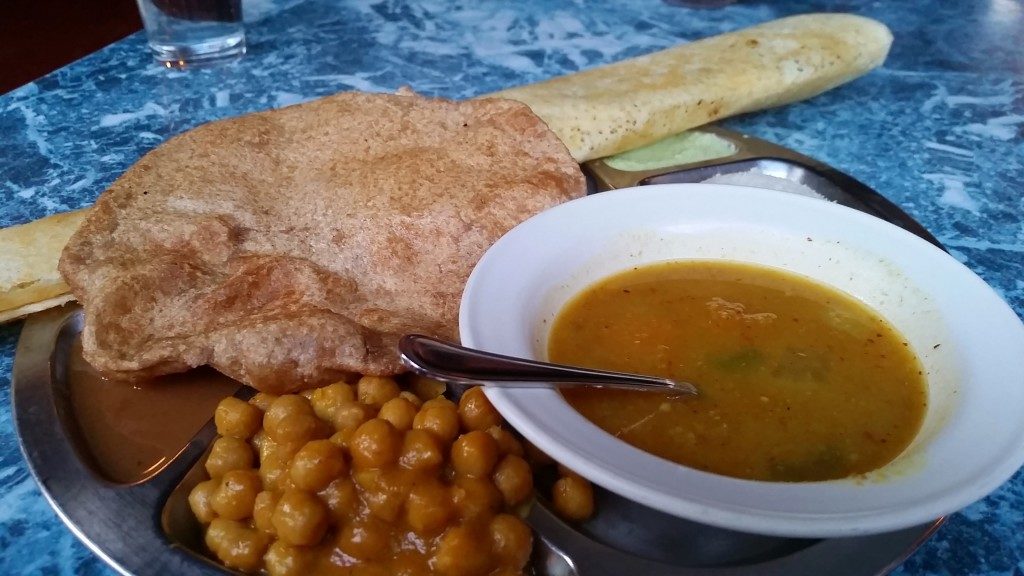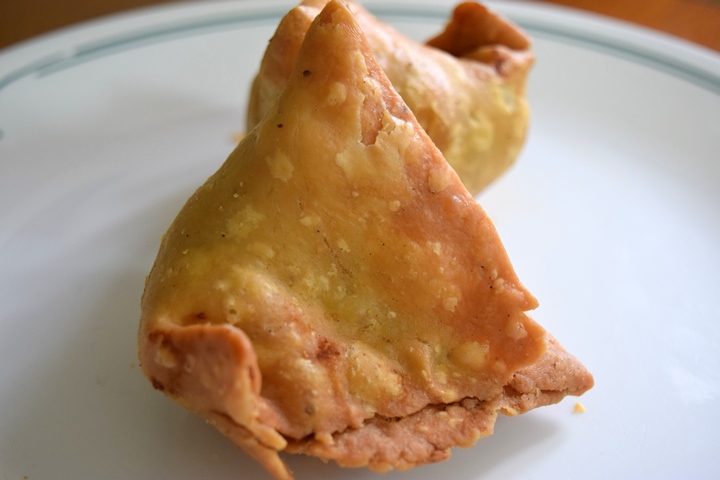Whenever I think of Indian food, I vividly remember lunchtime in second grade. As my class not-so-patiently awaited our turn to storm the sunny field, I pulled out my lunchbox and instantly froze as I recognized what was inside the two wraps of foil resting snugly within the box. I carefully scanned my surroundings before sneakily unwrapping the foil to reveal two puris with halva inside. Despite my efforts to be unnoticed, a surge of questions run me over: “What is that? Is that Indian food? Don’t all Indians eat curry?”
I may have been embarrassed back then, but not now.
Indian food is absolutely phenomenal. I say that having eaten it for the past sixteen years of my life, but it still holds true today. I’ve come to love and embrace the quirks of North Indian cuisine, and here’s a guide on how you can embrace it as well.
Breakfast

Photo courtesy of Christina Robinson
I fondly remember waking up at 5 am during my recent vacation to India when a vegetable salesman came trucking down the street of my residence yelling about radishes. I can never forget his howls as he called out the vegetables he was selling – some of which I hadn’t even heard of until that moment. What I do know, is that all of those vegetables were integral to my upcoming breakfast.
A typical North Indian breakfast consists of paratha, or whole wheat flatbread. The paratha is usually stuffed with aloo (potatoes), dal (lentils), palak (spinach), paneer (cottage cheese cubes), methi (fenugreek leaves), and of course, my beloved mulli (radishes). Top it off with butter with a side of tea, and you’ve got yourself a solid breakfast.
A major breakfast tradition involves everyone sitting together at the table until everyone has finished eating. I really enjoy this tradition because of the sense of unity and respect it has and the fact that it promotes much-needed face-to-face conversation.
Nowadays, work and school make it hard for everyone to eat at the same time. In addition, breakfast has shifted towards lighter meals, such as bhujia (deep-fried, crispy noodles with spices), suji toast (crispy toast), and biscuits (Parle G, anyone?) Despite this, most families take off work on Sundays for a heavy family brunch in order to preserve this tradition. Puri (deep-fried and puffy bread) and kulcha chhole (whole wheat bread served with a chickpeas sauce) are trademarks of these lazy Sundays.
Lunch

Photo courtesy of Eunice Choi
Lunch is arguably the most social part of the typical day, as the juiciest of stories come out with the juicy flavors of the meal. Roti, a style of flatbread that’s thinner than paratha, or rice (usually basmati rice, although there are many more varieties) are often paired with the plethora of vegetable or meat subzis, or side dishes. My personal favorite subzi is anything with paneer in it, but there’s a subzi out there just for you. Besides the roti and subzi, dahi (sweet yogurt) is added as a side to neutralize the spice of a dish. You can also grab any flavor of lassi (yogurt-flavored drink) for those hot summer afternoons.
A common practice during lunchtime is dabba/tiffin service, in which hot meals in lunchboxes are delivered to workers by way of dabbawalas. Tiffins are marked with special symbols that indicate the exact location of delivery, and are transported by bicycle or railroad to their destination. You can even text for dabba service nowadays.
Snacks

Photo courtesy of Paavani Jain
If you’re looking for a little something to chow down on between meals or serve as a light refreshment, there are plenty of options to choose from. Pictured is the samosa, which is a fried, triangular dish that can be filled with anything from potatoes to cheese to meat. Its crispy cousin, the pakora, requires less ingredients but still packs a flavorful punch.
Other snacks include aloo tikki (boiled potato croquettes), papri chaat (crispy wafers topped with chickpeas and sauces), and pav bhaji (vegetable curry with bread). A fun snack to serve is the pani puri, which consists of crisp and hollow mini puris that you poke a hole in and pour the special flavored water (pani) with sides of your choice.
However, it’s not all bread and butter when it comes to Indian snacks. With the reams of exotic fruits found in India, it’s not uncommon to have fruit as a snack. Pomegranates, mangoes, and lemons are some of the many natural fruits that grow in North India.
When Mother Nature decides to turn on the waterworks, a tradition is to snack on pakoras or poore with kheer, or sweet pancakes with rice pudding. It’s always fun to sit next to a rainy window while flooding your taste buds with hot and sweet flavors.
Dinner

Photo courtesy of Eunice Choi
If there’s one thing I can surely say about North Indian food, it’s not just curry – it’s bread, and lots of it. Naan, roti, paratha, chapati… the list goes on. Bread serves as a primary utensil besides your hands. Dinners are no exception to this rule – you have your basic bread (or rice) and side dish, vegetable or meat-based. You’re most likely to find a salad of sliced cucumbers (which are more useful than you might imagine) and carrots floating around the table in the evening. Sometimes, achar (pickles with spices) or chutneys are added as well. Recently, as with breakfast, dinners have become increasingly lighter with items such as crunchy moong dal and simple chapatis.
Since dinnertime is usually late in the day and most are ready to hit the pillows after dinner (who wouldn’t want to nap after a heavy meal?), a handful of saunf is consumed. These colorful fennel seeds aid with digestion, which is hindered when sleeping. Most restaurants will have containers of saunf on the counter next to the toothpicks, so make sure you grab a spoonful before you call it a night.
Dessert

Photo courtesy of Angie Oo
As I said before, the timing of Indian cuisine is often later than global norms. I call this Indian Standard Time. For example, inviting a guest for lunch or dinner means that you ask them to come two hours before you actually want them to come. Indian Standard Time has been the reason that I’ve missed public transportation, sweet sixteen entrances, and most importantly – dessert. Although it’s often overlooked, dessert is still an integral part of Indian dining and often comes immediately after dinner.
Gulab jamuns (pictured), gajrela (carrot-infused pudding), kheer (rice pudding) and rasmalai (milk-soaked cottage cheese patties) are sweet and succulent, and there are more flavors of burfi (milk pastries) and kulfi (Indian ice cream) than I can count. If you want to take it traditional, you can always stick to the classic mango slices. As long as you finish your meal, which denotes respect for your food, there are plenty of options to satisfy your sweet tooth.
The Verdict
Respect is a major theme when it comes to Indian cuisine and Indian culture as a whole. Whether it be respecting those you dine with by staying with them during a meal, finishing your meal to show appreciation for what you’ve been given, or following simple gestures such as providing a small portion of your food for local animals, Indian dining is all about courtesy. So yes, Indian food isn’t all curry. It’s a life lesson that keeps on giving.

